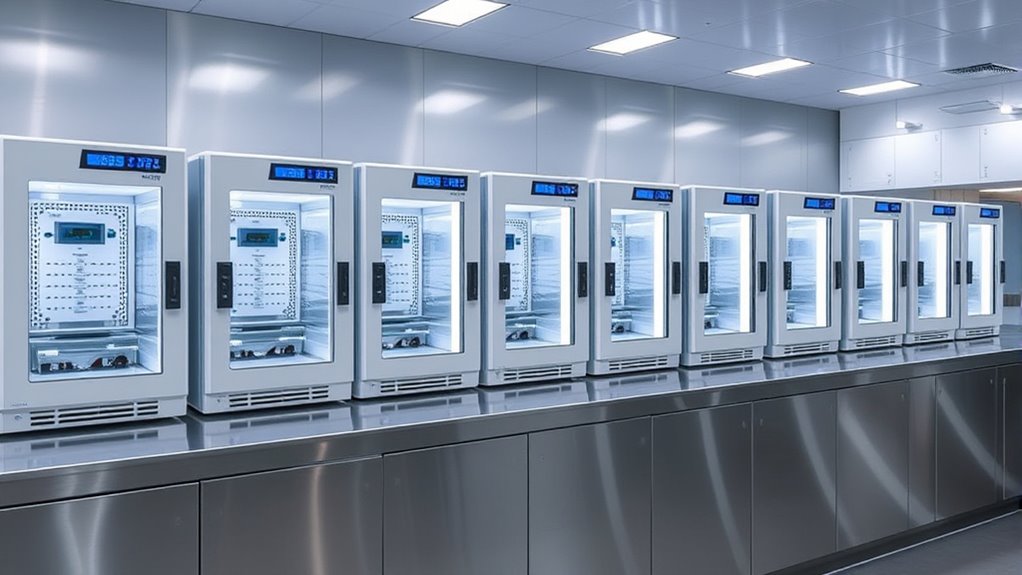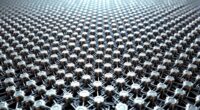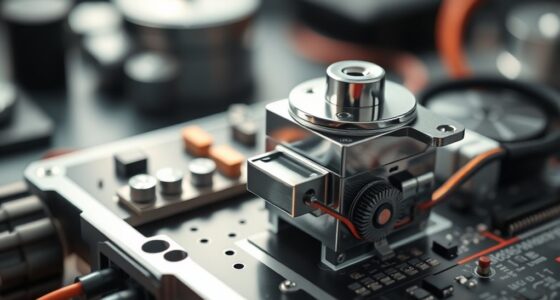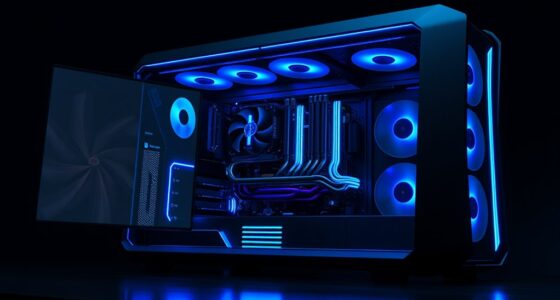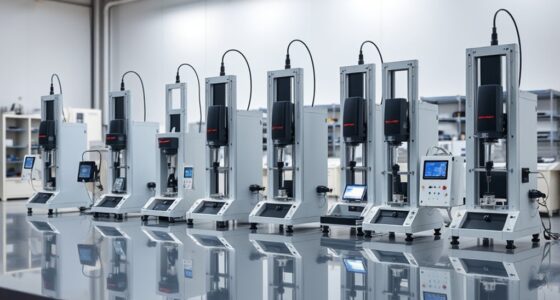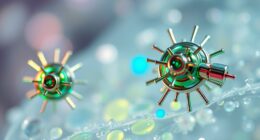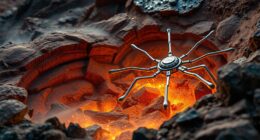If you’re looking for the 14 best environmental test chambers, I’ve found options that offer precise control for temperature, humidity, salt spray, and UV aging tests. These chambers feature durable materials, advanced safety features, and user-friendly controls, making them ideal for industries like electronics, automotive, and materials testing. Whether you need small-scale units or larger models, there’s a reliable choice for your needs. Keep going, and you’ll discover the key details of each to help you choose the right one.
Key Takeaways
- The list covers various types of chambers including UV aging, salt spray, and climatic chambers for comprehensive testing needs.
- Features include high-precision control, durable materials like SUS304 steel and acrylic, and safety functions for reliable operation.
- Suitable for industries such as electronics, automotive, aerospace, and coatings to test corrosion, weathering, and environmental resistance.
- Some models offer rapid heating, automatic spray control, and multi-mode testing for precise simulation of real-world conditions.
- Considerations include capacity, size, external equipment needs, maintenance, and compatibility with laboratory space and power supplies.
Constant Temperature Humidity Testing Chamber
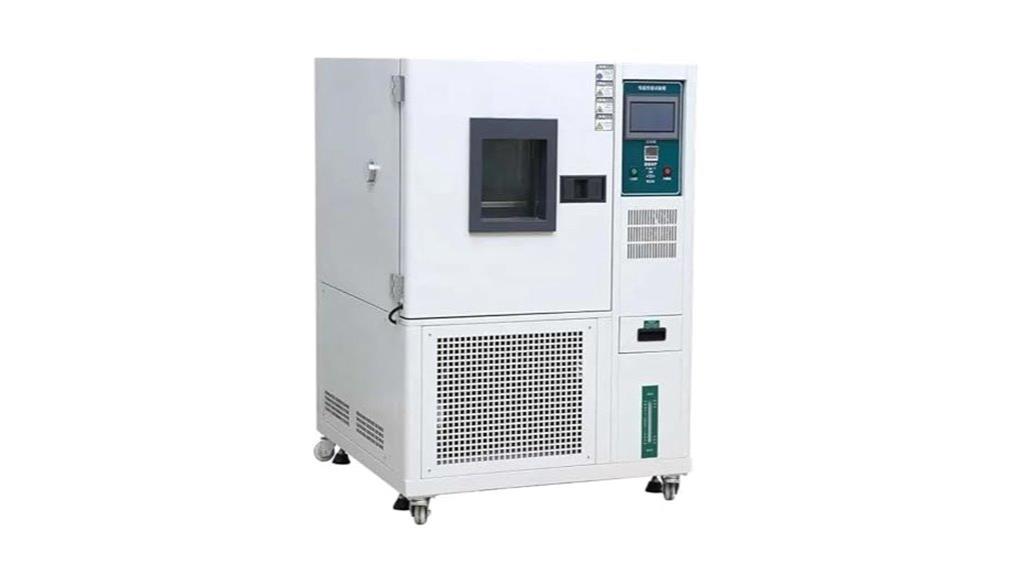
If you’re looking for a reliable testing solution to evaluate material durability under various environmental conditions, the Constant Temperature Humidity Testing Chamber is an excellent choice. I’ve used it to simulate extreme heat, cold, dryness, and moisture, helping me assess how materials perform over time. Its temperature range from -70°C to 150°C and humidity control from 20% to 98% RH allow precise testing. The chamber’s stainless steel interior, advanced control system, and safety features ensure accurate, consistent results. With a capacity of 80L and easy-to-use LCD interface, it’s perfect for laboratories requiring reliable environmental simulation.
Best For: laboratories and quality assurance teams seeking precise, reliable environmental testing for material durability under extreme conditions.
Pros:
- Accurate temperature and humidity control with high precision and resolution.
- Robust construction with stainless steel interior for durability and easy cleaning.
- Comprehensive safety features and fault diagnostics ensure reliable operation.
Cons:
- Limited capacity of 80L may not suit large-scale testing needs.
- Relatively heavy at 170kg, requiring sturdy setup space.
- The chamber’s size (L90×W102×H140cm) may be less suitable for larger samples or batch testing.
Salt Spray Testing Chamber, 110L with Timing Function
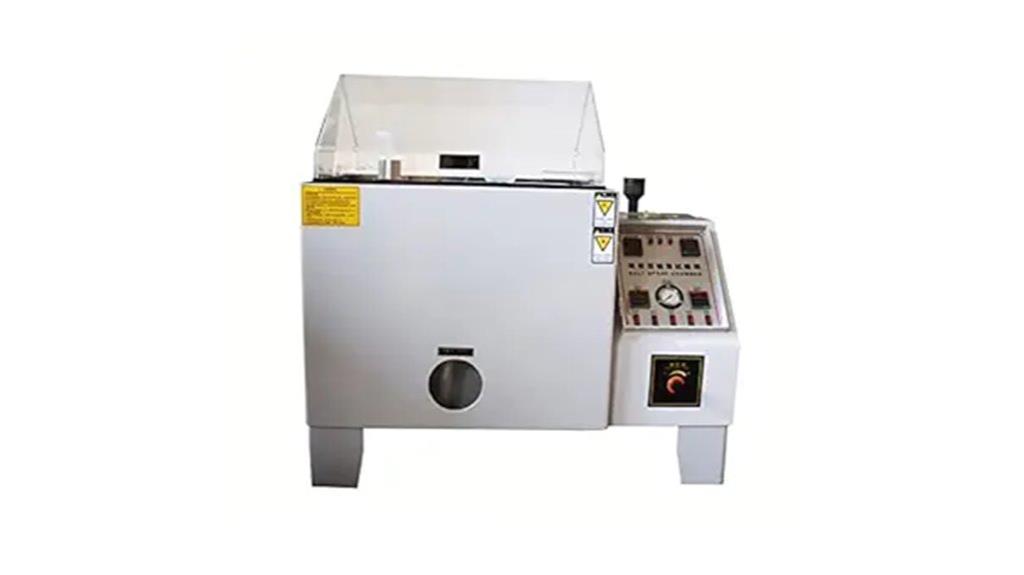
The Salt Spray Testing Chamber, 110L with Timing Function stands out as an ideal choice for laboratories and quality control teams seeking reliable corrosion testing. Its 110L volume and adjustable spray nozzles ensure uniform atomization, providing consistent results across large batches. The chamber’s automatic timing function simplifies operation by controlling spray cycles, while the durable construction—with high-quality acrylic and stainless steel components—ensures long-term reliability. Designed for ease of use, it effectively assesses the salt spray resistance of metallic coatings, helping you determine coating durability under simulated harsh conditions, making it a valuable tool for quality assurance and research.
Best For: laboratories, quality control teams, and researchers seeking reliable and efficient corrosion resistance testing for metallic coatings.
Pros:
- Provides uniform atomization and consistent spray results for accurate testing outcomes
- Equipped with automatic timing function for easy, hands-free operation
- Durable construction with high-quality acrylic and stainless steel components ensures long-term use
Cons:
- Requires connection to an external air compressor with a minimum capacity of 30L
- Limited to testing salt spray resistance on metallic coatings only
- Larger size may require substantial space for installation and storage
INTBUYING 110V Salt Spray Testing Chamber
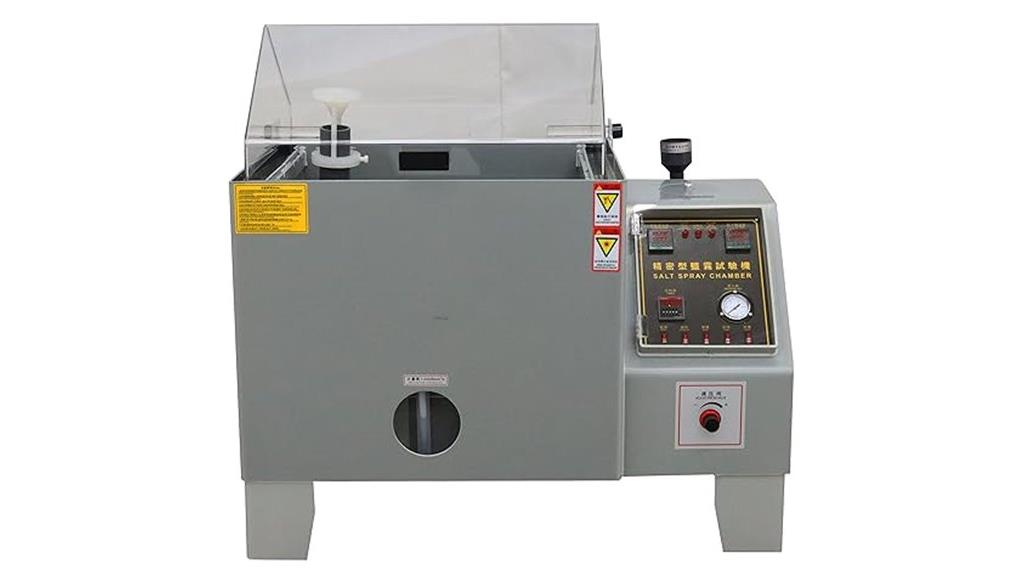
Designed for laboratories and quality control teams, the INTBUYING 110V Salt Spray Testing Chamber offers a reliable solution for evaluating corrosion resistance. Its 110L capacity and adjustable spray system ensure uniform fog distribution, simulating harsh salt spray environments effectively. The chamber features rapid, direct heating with a titanium tube, precise temperature control, and automatic safety functions like defogging and water replenishment. Made from durable imported PVC and European acrylic, along with SUS304 stainless steel components, it’s built for longevity and easy maintenance. With its efficient design, this chamber helps you accurately assess coatings, electroplating, and anti-corrosion treatments, ensuring your products meet strict quality standards.
Best For: laboratories, quality control teams, and manufacturers seeking reliable corrosion testing and evaluation of coatings, electroplating, and anti-corrosion treatments.
Pros:
- Durable construction with imported PVC, European acrylic, and SUS304 stainless steel for long-term use
- Precise temperature control with rapid direct heating and automatic safety features
- Large capacity (110L) and adjustable spray system for comprehensive and uniform corrosion testing
Cons:
- Requires a 110V power supply, limiting use in regions with different voltage standards
- Relatively large size may require significant laboratory space for setup
- Maintenance of spray nozzles and water levels can be time-consuming if not regularly monitored
HNZXIB UV Aging Test Chamber with 8 UV Lamps

For industries aiming to quickly assess material durability under simulated sunlight and weather conditions, the HNZXIB UV Aging Test Chamber with 8 UV lamps stands out as an ideal selection. It replicates accelerated weathering effects, including UV exposure, rain, and dew, to evaluate plastics, coatings, rubber, textiles, and more. The chamber features 8 UVA-340 lamps that simulate sunlight accurately, with adjustable irradiance. It combines condensation and water spray systems for thorough testing, supporting multiple modes like fading, cracking, and erosion. Its durable SUS304 construction, programmable touchscreen, and safety features ensure reliable, precise results, making it a top choice for quality validation.
Best For: industries seeking efficient, reliable testing of materials’ weathering resistance, including plastics, coatings, textiles, automotive, aerospace, and construction sectors.
Pros:
- Simulates sunlight, rain, and dew for comprehensive weathering testing
- Adjustable UV irradiance for customizable testing conditions
- Durable SUS304 steel construction with safety features for long-term use
Cons:
- Limited sample capacity may not suit large-scale production testing
- Requires 220V power supply, which may need adaptation in some regions
- Higher initial cost due to advanced features and certification compliance
Constant Climatic Temperature Humidity Test Chamber
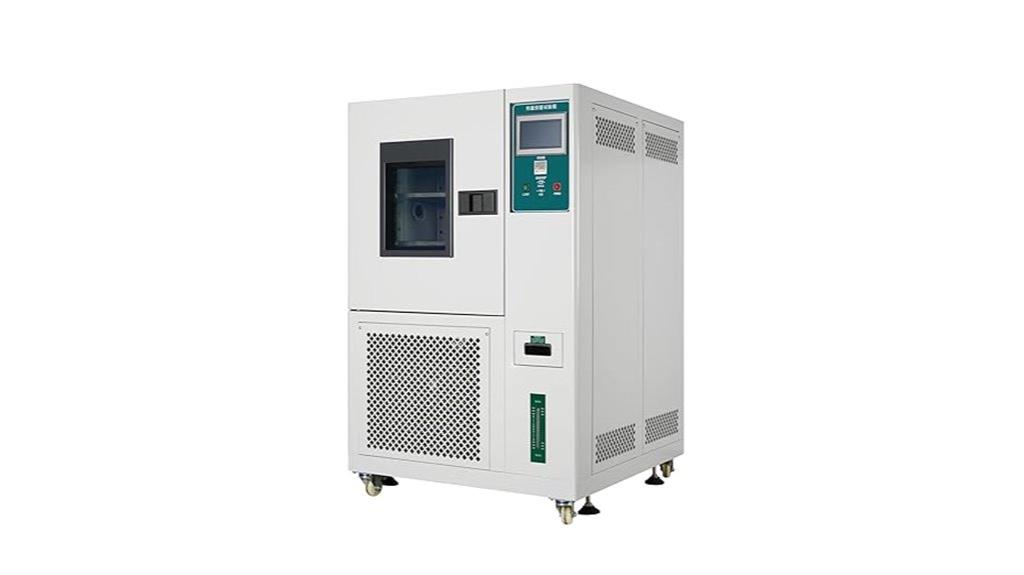
If you’re testing materials for resistance to extreme temperatures and humidity, the Constant Climatic Temperature Humidity Test Chamber offers precise control and reliable performance. It can simulate a wide temperature range from -70°C to 150°C and humidity levels from 20% to 98% R.H., ensuring accurate testing conditions. With an internal volume of 80 liters and advanced PID control, it maintains stability within ±1.0°C and ±2% R.H., with high-resolution adjustments. Its durable SUS#304 stainless steel construction, efficient cooling system, and all-encompassing safety features make it ideal for evaluating heat, cold, moisture, and dry resistance in various materials.
Best For: researchers and manufacturers needing precise climate simulation for testing material durability under extreme temperature and humidity conditions.
Pros:
- Offers a wide temperature range from -70°C to 150°C for versatile testing needs.
- High accuracy with ±1.0°C and ±2% R.H., ensuring reliable results.
- Durable construction with SUS#304 stainless steel and advanced safety features for long-term use.
Cons:
- Relatively heavy and large, potentially requiring substantial space and setup.
- Limited internal volume of 80 liters may restrict testing of larger samples.
- Complex control system may require training for optimal operation.
INTSUPERMAI Steam Aging Test Machine with LED Display & PID+SSR Control
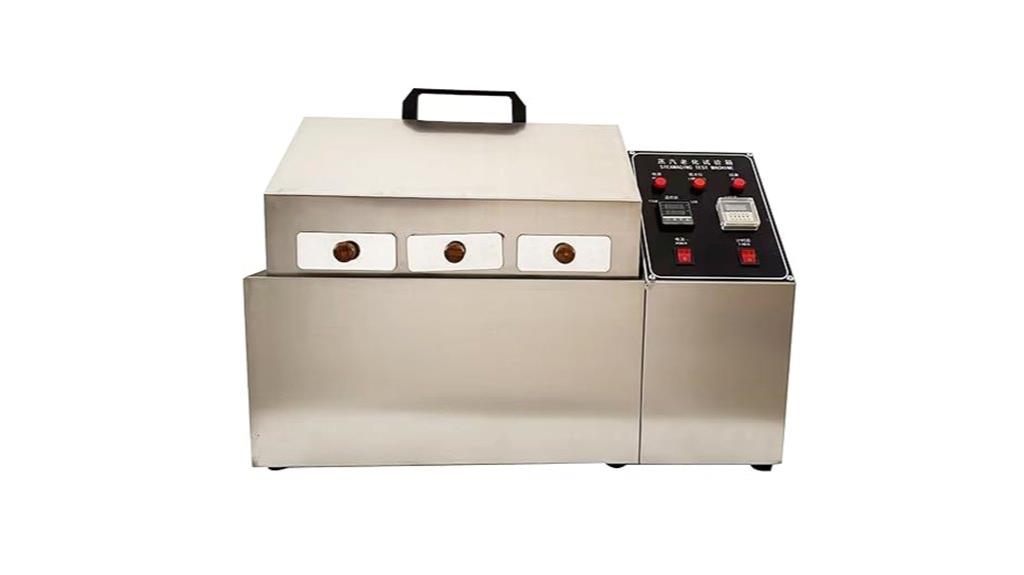
The INTSUPERMAI Steam Aging Test Machine with LED display and PID+SSR control stands out for its precise temperature regulation and user-friendly operation, making it an ideal choice for professionals seeking reliable aging tests. Its microcomputer temperature controller ensures accurate, consistent results, while the LED digital display provides clear monitoring. The control panel is straightforward, featuring essential functions like power, timer, and temperature controls, plus a one-key start for ease of use. With three test chambers and a drawer-type design, it allows multiple simultaneous tests and easy sample handling. This machine is perfect for accelerated aging of electronic components such as ICs, capacitors, and connectors.
Best For: electronics manufacturers and quality assurance professionals seeking precise, reliable accelerated aging tests for electronic components.
Pros:
- Microcomputer PID control ensures accurate and stable temperature regulation.
- Multiple test chambers allow for simultaneous testing, increasing efficiency.
- User-friendly LED display and one-key start simplify operation and monitoring.
Cons:
- The machine may require trained personnel to operate complex settings effectively.
- Larger size and multiple chambers might limit space in smaller laboratories.
- Initial investment cost can be high for small-scale or hobbyist users.
Salt Spray Testing Chamber, 270L, Inner Diameter 900x600x450mm
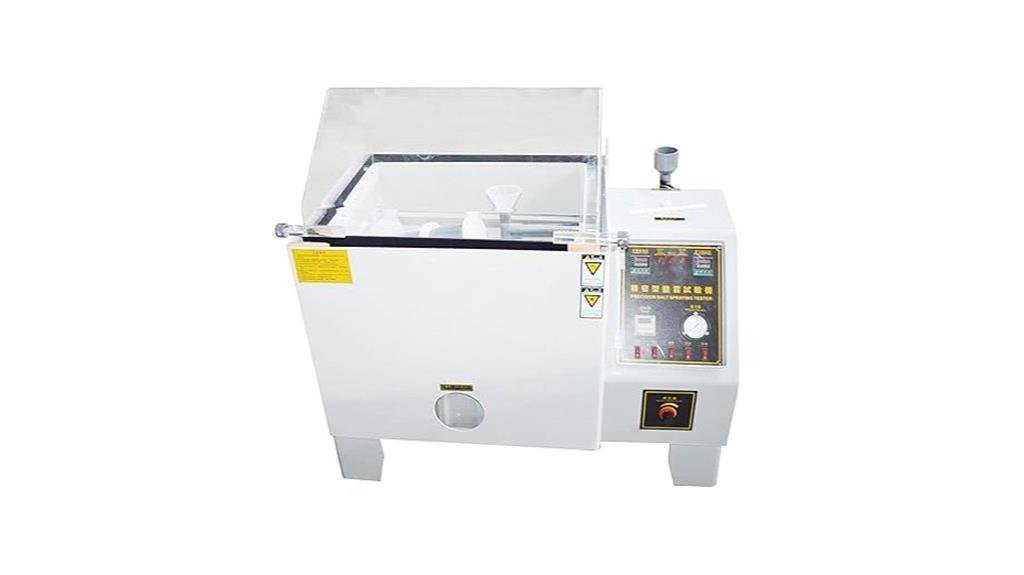
This 270L Salt Spray Testing Chamber stands out as an ideal choice for laboratories and quality control teams seeking reliable corrosion resistance testing. Its inner dimensions of 900x600x450mm allow for testing multiple samples simultaneously. Designed to simulate harsh environments, it sprays sodium chloride solution continuously to assess the durability of metallic coatings, especially electrodeposited ones. Made with high-quality materials like a 5mm acrylic seal cover and SUS304 stainless steel pressure tank, it guarantees durability and safety. To operate, I connect it to an air compressor, making it a practical solution for consistent, precise salt spray testing in demanding industrial environments.
Best For: laboratories and quality control teams seeking reliable, durable, and efficient corrosion resistance testing of metallic coatings, especially electrodeposited coatings.
Pros:
- High-capacity chamber allows testing multiple samples simultaneously, increasing productivity.
- Made with durable, high-quality materials like acrylic and SUS304 stainless steel for long-lasting use.
- Features adjustable spray nozzles for uniform atomization, ensuring consistent testing conditions.
Cons:
- Requires connection to an external air compressor, which may involve additional setup and cost.
- Outer dimensions are large, potentially requiring ample space in the laboratory.
- Continuous spray operation may lead to higher water and power consumption during testing.
Salt Spray Chamber for Corrosion Testing, 110V
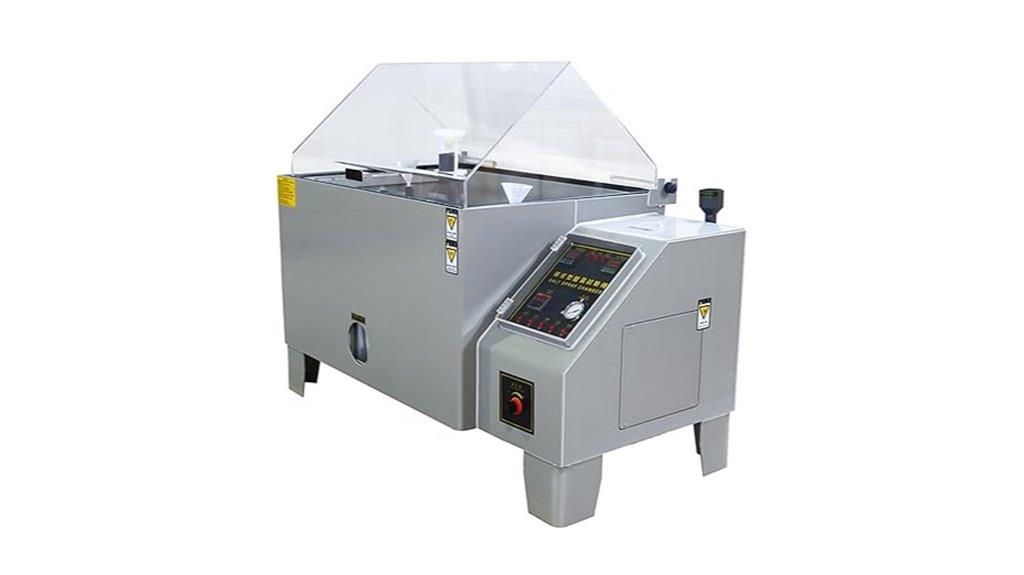
For professionals seeking reliable corrosion resistance testing, the Salt Spray Chamber for Corrosion Testing, 110V stands out with its precise control system and ample testing volume. It features an intelligent control panel with easy operation, a transparent plexiglass cover for visual monitoring, and adjustable baskets for uniform spray distribution. The chamber uses sodium chloride solution spray to simulate corrosive environments, with temperature controls for the pressure and salt water barrels. Designed for testing metallic coatings, especially electrodeposited layers, it ensures consistent results. Its robust construction and extensive features make it ideal for evaluating the durability of various metallic materials under salt fog conditions.
Best For: professionals and laboratories seeking precise, reliable corrosion resistance testing for metallic coatings and electrodeposited layers.
Pros:
- Equipped with an intelligent control panel for easy operation and accurate timing
- Features adjustable baskets ensuring uniform spray distribution on all test samples
- Transparent plexiglass cover allows for real-time visual monitoring of test progress
Cons:
- Requires a separate air compressor, which must be purchased separately
- Limited to 110V power supply, restricting use in regions with different voltage standards
- The solution flow rate must be carefully controlled to prevent contamination and ensure test accuracy
Malockos SK1-602 Stainless Steel Handle Oven

If you’re seeking a reliable handle component for high-temperature and humidity environments, the Malockos SK1-602 Stainless Steel Handle Oven stands out with its robust construction. Made from durable SUS304 stainless steel, it resists corrosion and can withstand extreme temperatures, ensuring long-lasting performance. Its large tightening capacity makes it ideal for precise handling in ovens and environmental test chambers. Whether used as a handle component in temperature or humidity testing equipment, this super-large tightening handle offers strength and reliability. Manufactured in China with customizable processing options, it’s a practical choice for maintaining secure, stable operations in demanding testing environments.
Best For: professionals and technicians needing a durable, high-temperature resistant handle for ovens, environmental test chambers, or related equipment requiring secure handling.
Pros:
- Made from high-quality SUS304 stainless steel, ensuring corrosion resistance and durability
- Large tightening capacity for secure and precise operation
- Suitable for demanding environments with high temperatures and humidity
Cons:
- Customizable processing options may lead to longer lead times
- Heavier than plastic handles, potentially affecting ease of installation
- Limited to use as a handle component, not a complete product for other applications
Salt Spray Chamber for Corrosion Testing, 110L, 110V
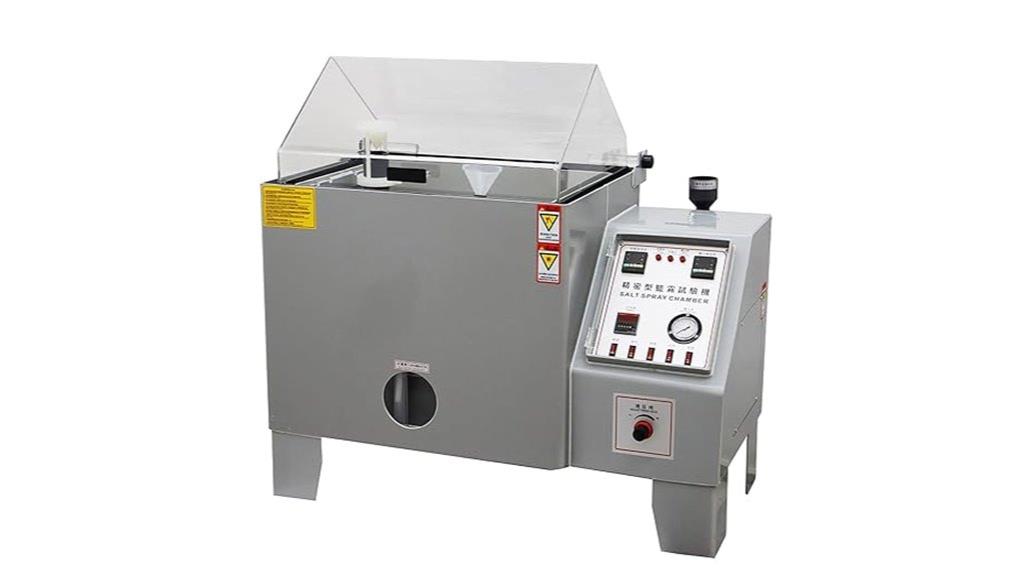
The Salt Spray Chamber for Corrosion Testing, 110L, 110V, stands out as an ideal choice for labs and quality control facilities seeking reliable, standardized corrosion resistance testing. Its durable construction features 5 mm thick imported PVC panels, acrylic seals, and a SUS304 stainless steel pressure tank that withstands high pressure and maintains thermal insulation up to 85°C. The chamber uses a pure titanium heating tube for quick, efficient heating, with automatic shutdown for precision. Equipped with an intelligent control panel, it allows easy setting of test durations and monitoring of temperature and pressure. Its continuous spray method effectively evaluates coating durability, ensuring consistent, accurate corrosion resistance results.
Best For: laboratories and quality control facilities seeking reliable, standardized corrosion resistance testing of coatings and surface treatments.
Pros:
- Durable construction with high-quality materials like imported PVC panels and SUS304 stainless steel pressure tank
- Efficient heating system using pure titanium tubes with automatic temperature control for precise results
- User-friendly intelligent control panel for easy setting of test parameters and real-time monitoring
Cons:
- Requires customers to supply their own air compressor, as it is not included in the package
- Random delivery of panels may lead to variability in appearance between units
- The chamber’s size and setup may require sufficient laboratory space and proper handling for installation
UV Accelerated Aging Test Chamber with Spray Function for Plastic, Rubber & Textile Testing
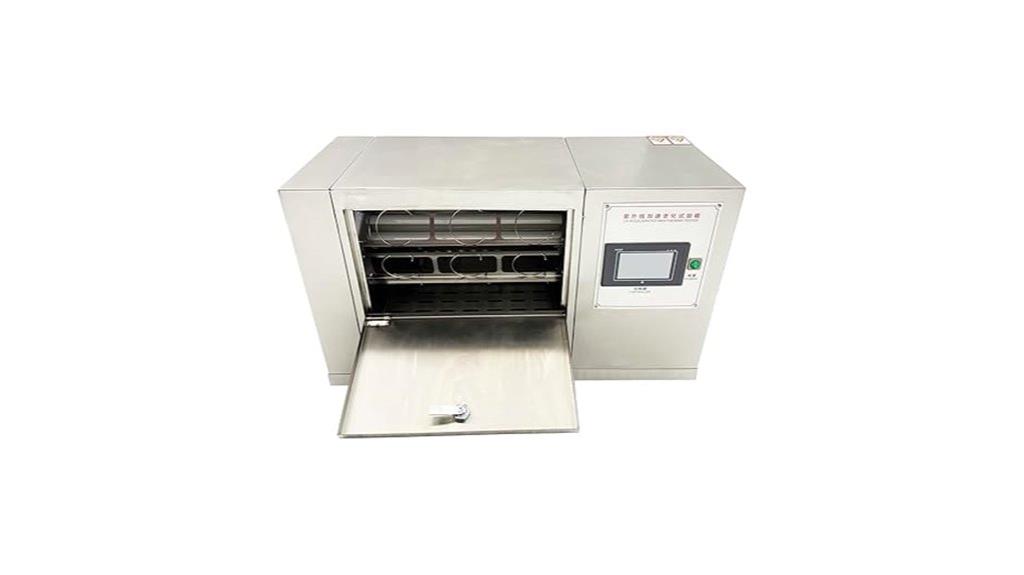
The UV Accelerated Aging Test Chamber with Spray Function is an excellent choice for professionals seeking rapid, reliable weathering simulations of plastics, rubbers, textiles, coatings, and resins. It uses triple UVA-340nm lamps to replicate the solar UV spectrum, delivering outdoor weathering effects in days—equivalent to months—per ASTM standards. The chamber features an intuitive touch screen, auto-rotation for uniform exposure, and adjustable spray cycles with a high-capacity water pump. Constructed from durable SUS304 stainless steel, it withstands harsh conditions, ensuring long-term stability. With versatile testing options, this chamber accelerates material durability assessments, making it ideal for quality control, product development, and research across multiple industries.
Best For: professionals and researchers in industries such as plastics, rubber, textiles, coatings, and resins seeking rapid, reliable outdoor weathering simulation for quality control, product development, and durability testing.
Pros:
- Provides accelerated weathering tests using UVA-340nm lamps that replicate the solar UV spectrum with high accuracy.
- Features an intuitive touch screen interface and auto-rotation for uniform sample exposure.
- Constructed from durable SUS304 stainless steel, ensuring long-term stability and resistance to harsh environmental conditions.
Cons:
- Requires a dedicated power supply of AC110V and may need additional space for setup.
- Limited to 24 samples at a time, which might be insufficient for very high-volume testing.
- The high-capacity water pump and spray system may increase maintenance requirements.
855-ACB Controlled Atmosphere Chamber, Double Chamber
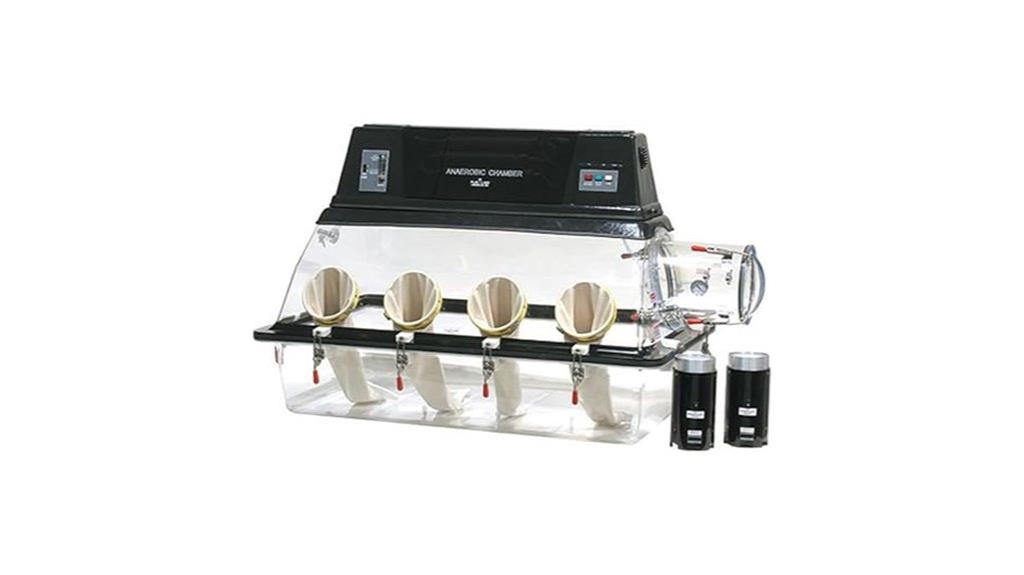
Designed for precision and versatility, the 855-ACB Controlled Atmosphere Chamber with double chambers is ideal for laboratories and industries requiring strict atmospheric control. Its dual-chamber setup allows simultaneous testing under different conditions, boosting efficiency. Features such as automatic inner doors on transfer chambers and self-sealing quick disconnects simplify maintenance and minimize atmosphere disruption. With dedicated vacuum pumps and adjustable pressure gauges, I can meticulously manage environments. The chamber’s durable acrylic and thermoset construction, combined with illuminated controls and Hyperon gloves, ensures safe, accurate operation. Certified with UL-CSA approval, it’s a reliable solution for sensitive testing environments demanding consistency and control.
Best For: laboratories and industries requiring precise atmospheric control and simultaneous testing under different conditions for sensitive processes.
Pros:
- Dual-chamber design enhances testing efficiency and versatility.
- Automated doors and quick disconnects simplify maintenance and reduce atmosphere disruption.
- Durable acrylic and thermoset construction ensure longevity and clear visibility during operation.
Cons:
- May have a higher initial cost due to advanced features and construction materials.
- Requires trained personnel for optimal operation and maintenance.
- Larger footprint might demand significant space in the laboratory or facility.
110L Salt Spray Testing Chamber for Salt Fog Corrosion Test
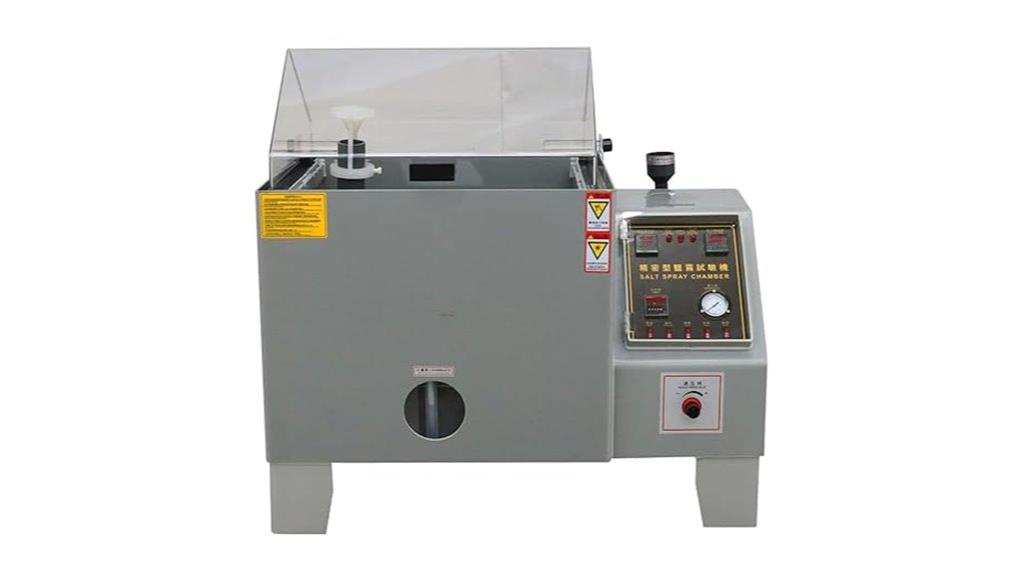
If you need reliable salt spray testing to assess corrosion resistance, the 110L Salt Spray Testing Chamber stands out because of its rapid heating capabilities and precise control features. It simulates saltwater spray conditions to evaluate coatings, electroplated surfaces, and other materials’ durability. The chamber features a high corrosion-resistant titanium heating tube for quick temperature response, reducing standby time and power use. Its durable ABS body and 304 stainless steel pressure tank ensure longevity. Equipped with Bernoulli atomization nozzles, it guarantees even spray distribution. With a digital control panel, adjustable pressure, and carefully maintained salt concentration, it provides consistent, accurate testing for a variety of corrosion-resistant materials.
Best For: professionals and laboratories seeking reliable, rapid, and precise salt spray corrosion testing for evaluating the durability of coatings and materials under simulated salty environmental conditions.
Pros:
- Rapid heating with high corrosion resistance due to titanium heating tubes, reducing testing time and energy consumption
- Precise control over internal conditions including pressure, temperature, and salt concentration for consistent results
- Durable construction with ABS plastic body and stainless steel pressure tank ensures long-term use and easy maintenance
Cons:
- Limited chamber capacity at 110L may not accommodate very large samples or multiple test pieces simultaneously
- Requires careful preparation and maintenance of salt solution to ensure accurate testing conditions
- Adjustable nozzles and multiple settings may require training or experience for optimal operation
Steam Aging Test Machine with PID + SCR Controller, 110V
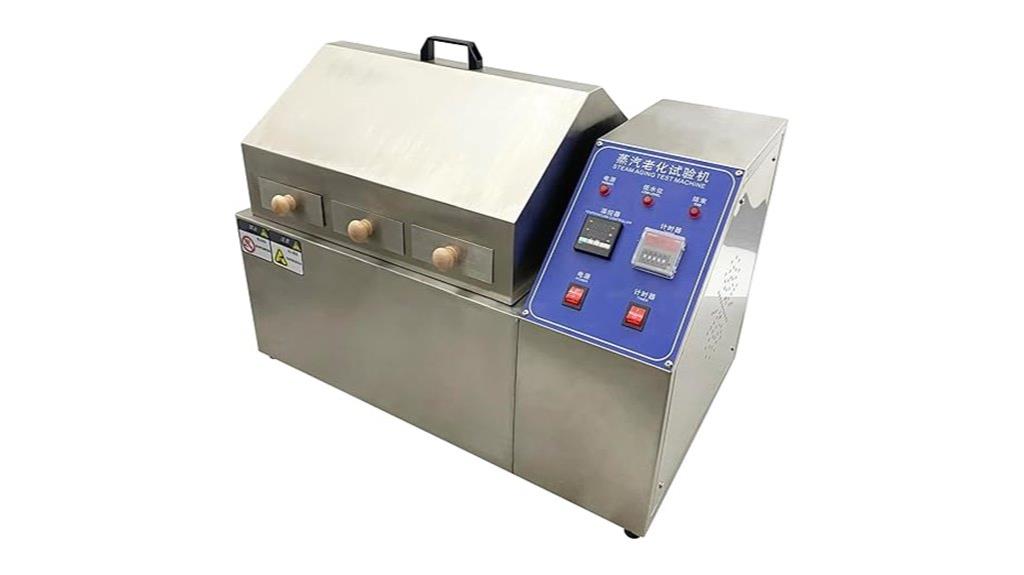
For professionals seeking reliable and precise steam aging testing, the Steam Aging Test Machine with PID + SCR Controller, 110V, stands out as an excellent choice. It simulates the lifespan of electroplating elements through accelerated environmental testing, ensuring product durability. Built with high-quality SUS304 stainless steel, it’s corrosion-resistant and durable. Its three separate chambers allow simultaneous testing of multiple components, saving time. The microcomputer control system offers accurate temperature regulation within ±0.5°C, heating up to 97°C in about 45 minutes. Supporting long-term operation up to 9999 hours, it’s ideal for consistent, high-precision testing in industrial and laboratory environments.
Best For: professionals and laboratories requiring precise, reliable steam aging tests for electronic components and electroplating elements.
Pros:
- High-precision temperature control with ±0.5°C accuracy using PID + SCR technology.
- Multiple chambers allowing simultaneous testing of different components, improving efficiency.
- Durable SUS304 stainless steel construction ensures corrosion resistance and long-term use.
Cons:
- Relatively heavy and large, which may require substantial space for setup.
- Heating time of approximately 45 minutes may delay testing start times.
- Limited to 110V power supply, restricting use in regions with different voltage standards.
Factors to Consider When Choosing Environmental Test Chambers

When selecting an environmental test chamber, I focus on key factors like capacity to make certain it fits my testing needs and temperature range flexibility for different conditions. I also consider humidity control accuracy and the durability of construction materials to guarantee long-term reliability. Additionally, programmable testing features can streamline complex testing protocols, so I weigh these options carefully.
Test Chamber Capacity
Choosing the right environmental test chamber involves carefully considering its capacity to guarantee accurate and efficient testing. The chamber’s size, measured in liters or cubic feet, determines how many samples or the size of items you can test simultaneously. Larger chambers, like those with 270L capacity or 1100mm inner diameter, support multiple samples or bigger items, boosting throughput. Smaller models, such as 80L or 110L chambers, are ideal for testing individual components, saving space and energy. It’s essential to match the chamber’s capacity with your testing needs—overcrowding can compromise test accuracy, while undersized chambers limit sample exposure. Proper capacity ensures uniform environmental conditions, leading to reliable, consistent results across all tests.
Temperature Range Flexibility
A flexible temperature range is essential because it determines how well a test chamber can simulate a variety of environmental conditions. A wider range, such as -70°C to 150°C, lets me test materials under extreme cold and heat, revealing durability limits. Precise control, with accuracy within ±0.5°C, ensures I can replicate real-world temperature fluctuations reliably. Quick heating or cooling capabilities, like ≤3°C/min heating and ~1°C/min cooling, improve testing efficiency and help me observe material responses across temperature extremes. Adjustable temperature settings allow me to tailor tests to specific protocols and material requirements. Supporting the necessary temperature span guarantees accurate performance assessment under different environmental stresses, making the chamber versatile for a broad spectrum of testing scenarios.
Humidity Control Accuracy
Accurate humidity control plays a essential role in replicating real-world environmental conditions within test chambers. High precision is usually specified as ±1.0°C and ±2% RH, with advanced models reaching ±0.5°C and ±2% RH for more delicate testing. The resolution often reaches ±0.1% RH, enabling fine adjustments vital for sensitive materials. Reliable sensors like PT100 or T thermocouples provide consistent feedback, ensuring stable humidity levels. Fluctuations can occur due to poor insulation, compressor issues, or water quality problems, negatively affecting test results. To maintain accuracy, a well-calibrated control system with PID adjustments is essential. This setup compensates for environmental fluctuations over time, ensuring that humidity remains steady and test conditions are reliable and repeatable.
Construction Material Durability
Selecting construction materials with high durability is essential for ensuring environmental test chambers withstand demanding conditions over time. I look for materials like SUS304 stainless steel and high-quality acrylic, which resist corrosion, high temperatures, and chemical exposure. These materials help the chamber maintain structural integrity during prolonged use. Insulating materials such as polyurethane foam and superfine wool also play a crucial role by preventing thermal degradation and reducing energy loss, thereby extending the chamber’s lifespan. Using high-pressure resistant stainless steel in components like pressure tanks and spray nozzles ensures they can handle operational stresses without failure. Choosing corrosion- and wear-resistant materials not only enhances durability but also reduces maintenance needs and replacement costs, ensuring reliable performance throughout the chamber’s service life.
Programmable Testing Features
When selecting an environmental test chamber, it’s vital to take into account its programmable testing features, as they determine how effectively the chamber can simulate real-world conditions. Advanced programmable chambers let you set complex cycles with specific temperature, humidity, and exposure times, ensuring precise simulations. Multi-step programs with numerous segments enable customized testing sequences that can last from seconds to days, offering flexibility. Many chambers also include data logging and export options, allowing detailed analysis of environmental conditions and results over time. User-friendly interfaces, such as touchscreens, make setup and adjustments straightforward. Additionally, safety features like fault detection can automatically pause or stop tests if abnormal conditions occur, protecting both the equipment and the integrity of your testing process.
Maintenance and Safety
Regular maintenance is essential to keep environmental test chambers operating reliably and to prevent costly malfunctions. Regularly inspecting seals, filters, and sensors ensures consistent performance and helps identify issues early. Safety features like over-temperature protection, water shortage alarms, and phase shortage alerts are critical for preventing damage and protecting operators. Periodic calibration of temperature, humidity, and other controls maintains testing accuracy within specified tolerances. Proper training on operation and safety procedures reduces risks like electrical faults or chemical leaks. Routine cleaning and inspection of internal components, such as humidifiers and refrigeration systems, extend the chamber’s lifespan and ensure reliable results. Prioritizing maintenance and safety when choosing a chamber guarantees dependable performance, safety, and compliance with industry standards.
Frequently Asked Questions
What Are the Maintenance Requirements for Environmental Test Chambers?
Maintaining environmental test chambers is vital for accurate results. I regularly clean filters and check seals to prevent contamination and leaks. I also calibrate sensors and control systems as recommended by the manufacturer, typically every few months. Additionally, I inspect and lubricate moving parts, and monitor the chamber’s temperature and humidity stability. Consistent maintenance ensures reliable operation, prolongs equipment life, and guarantees precise testing conditions for my projects.
How Do I Calibrate the Chambers for Accurate Results?
Think of calibration as tuning a fine instrument; it makes certain your chamber hits the right notes. I start by referencing the manufacturer’s guidelines and using certified calibration standards. I regularly check temperature, humidity, and pressure readings with precise instruments, adjusting controls until readings match the standards exactly. This keeps my test results reliable and consistent, like a well-tuned symphony, so I know my chamber’s environment remains just right for accurate testing.
What Safety Features Are Included in These Chambers?
I guarantee safety with these chambers by including features like emergency stop buttons, over-temperature and over-pressure alarms, and automatic shut-off systems. Many also have door interlocks to prevent accidental opening during operation and reinforced panels for physical protection. Regular maintenance and calibration are essential, but these safety features give me peace of mind by preventing accidents and ensuring the equipment operates securely and reliably during testing.
Are There Energy-Efficient Models Available?
Yes, there are energy-efficient models available. I recommend looking for chambers with advanced insulation, energy-saving compressors, and programmable controls that optimize power usage. Many modern chambers are designed with eco-friendly features to reduce energy consumption without sacrificing performance. By choosing these models, you not only save on operational costs but also support sustainability efforts. I encourage you to compare specifications to find the most efficient option for your testing needs.
How Long Is the Typical Lifespan of an Environmental Test Chamber?
Typically, an environmental test chamber lasts between 10 to 15 years with proper maintenance. I’ve seen models stay reliable for over a decade when regularly serviced and calibrated. Factors like usage intensity, environmental conditions, and build quality influence longevity. I recommend scheduling routine inspections and keeping spare parts on hand to extend your chamber’s lifespan. Investing in a reputable brand also helps guarantee you get a durable, long-lasting piece of equipment.
Conclusion
When choosing an environmental test chamber, I know it can feel overwhelming—like finding a needle in a haystack of options. But remember, the right chamber is your secret weapon for pinpoint accuracy and reliability in testing. With the right choice, you’ll achieve results so precise, they’ll make even the most complex environments look like child’s play. Trust me, investing wisely here transforms your testing process into a smooth, unstoppable force.
